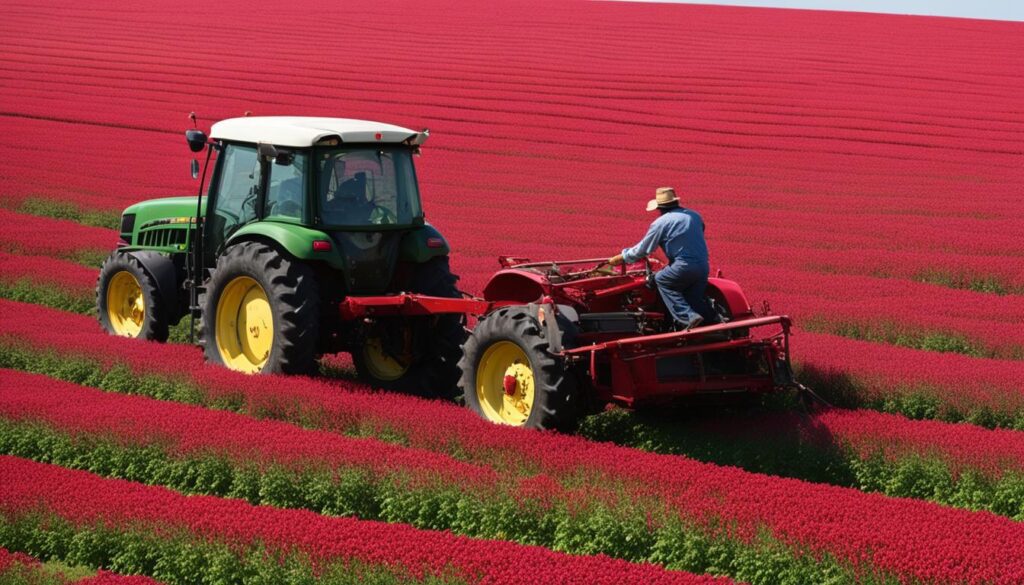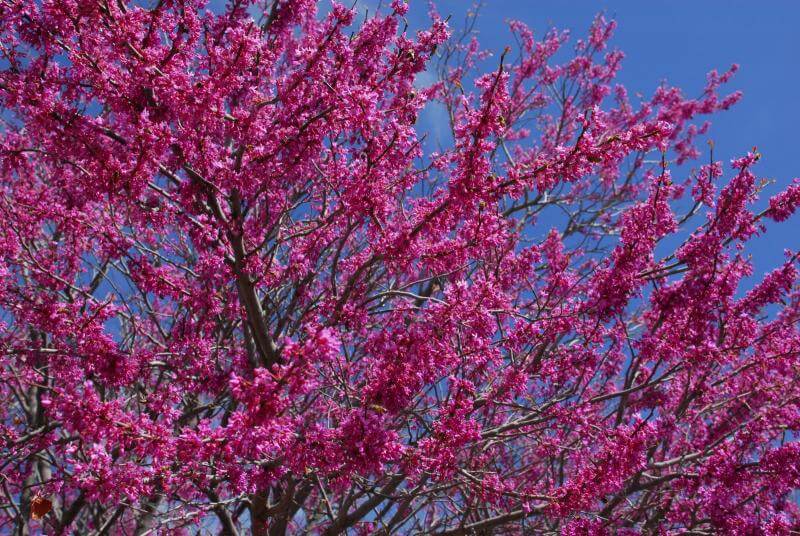Clover is a diverse group of plants with various species and characteristics. Whether you’re a farmer, landscaper, or nature enthusiast, understanding the different types of clover can provide valuable insights into their unique features and uses. In this article, we will explore the wide range of clover varieties, from cold-tolerant annuals to native species found in specific regions. Get ready to dive into the world of clover and discover the fascinating characteristics that make each variety special.
Key Takeaways:
- Clover is a diverse group of plants with various species and characteristics.
- Understanding the different types of clover can provide valuable insights into their unique features and uses.
- Clover varieties include cold-tolerant annuals, native species, and types classified by leaf size.
- Each clover variety offers different benefits for forage, cover crops, and grassland health.
- Choosing the right clover variety depends on specific purposes, climate, and soil conditions.
eNhance Persian Clover: Cold-Tolerant Annual Clover
Introducing eNhance Persian Clover, a remarkable cold-tolerant annual clover variety offered by GO Seed. This versatile clover exhibits exceptional characteristics that make it a valuable addition to your agricultural practices.
One of the standout features of eNhance Persian Clover is its cold tolerance, allowing it to thrive even in harsh winter conditions. It has been tested and proven to withstand temperatures as low as -15 degrees Fahrenheit, making it an ideal choice for regions with cold climates.
Not only does eNhance Persian Clover excel in cold tolerance, but its root development speed is comparable to that of daikon radish. This attribute makes it particularly suitable for sandy soils, where its root system aids in improving soil structure and nutrient availability.
Another advantage of eNhance Persian Clover is its rapid establishment. It quickly takes root and establishes itself in the soil, providing reliable groundcover and erosion control. This characteristic makes it a popular choice for mixtures with cereal rye, as it complements the growth patterns and benefits of the companion plant.
As an annual clover, eNhance Persian Clover grows and completes its life cycle within a single year. This allows for flexibility in crop rotation and management, providing opportunities to integrate it into various cropping systems.
“The cold-tolerant nature of eNhance Persian Clover makes it a resilient and reliable option for farmers and ranchers in colder climates. Its ability to establish quickly and enhance soil quality makes it an asset to any agricultural operation.”
Q Medium Red Clover: Tolerance to Broadleaf Herbicide
Q Medium Red Clover, licensed to GO Seed by the Florida Foundation Seed Producers, is a variety known for its tolerance to the broadleaf herbicide 2-4,D. This makes it a valuable option for farmers looking to effectively manage weed growth in their pastures.
One of the key features of Q Medium Red Clover is its early maturing nature, which allows for timely biomass production. This ensures that farmers can benefit from its high yield potential within a shorter timeframe. Additionally, Q Medium Red Clover is suitable for pastures that already contain grasses, as it complements their growth rather than competing with them.
Another advantage of Q Medium Red Clover is its absence of erucic acid and glucosinolates, making it a safer and healthier option for livestock consumption. This variety’s rapid establishment plays a crucial role in superior weed suppression, helping to maintain a clean and productive pasture for livestock grazing.
Moreover, Q Medium Red Clover possesses a tap root that helps alleviate soil compaction. By penetrating deep into the soil, the tap root improves soil structure and drainage, contributing to enhanced overall pasture health.
Q Medium Red Clover Benefits:
- Tolerance to the broadleaf herbicide 2-4,D
- Early maturing with excellent biomass production
- Compatible with existing grass pastures
- Free from erucic acid and glucosinolates
- Rapid establishment for superior weed suppression
- Tap root helps alleviate soil compaction
With its broadleaf herbicide tolerance and numerous advantages, Q Medium Red Clover is a reliable choice for farmers seeking to maintain healthy and productive pastures. The next section will focus on California native clovers and their significant role in grassland health.
California Native Clovers: Unsung Heroes of the Meadow
California is home to a variety of native clovers that play a crucial role in grassland health. These native clover species, such as pinpoint clover, notch leaf clover, tomcat clover, and more, enhance soil fertility by fixing nitrogen. These unsung heroes of the meadow coexist without competing with other plants and indicate good site quality. Native clovers are an essential part of grassland ecosystems and thrive in locations free from invasive species.
California native clovers contribute to the overall grassland health by improving soil composition and nutrient availability. Their ability to fix nitrogen helps enrich the soil, providing a natural fertilizer for other plants in the ecosystem.
These native clovers also form a symbiotic relationship with soil bacteria known as rhizobia, which allows them to convert atmospheric nitrogen into a usable form. This process not only benefits the clovers themselves but also neighboring plants, contributing to the overall health and productivity of the grassland.
Furthermore, native clovers require minimal maintenance and can thrive in a variety of soil types, making them well-suited for California’s diverse landscapes. Their resilience and adaptability make them valuable additions to both agricultural fields and natural meadows.
By recognizing the importance of California native clovers and promoting their growth, we can ensure the preservation and restoration of thriving grasslands. The conservation of these native species is vital for maintaining biodiversity and supporting the overall health of our ecosystems.
Red Clover Varieties: Early and Late Flowering Types
Red clovers offer a diverse range of varieties based on their flowering periods. Understanding the distinctions between early and late flowering types is essential when selecting the right red clover for your specific needs.
Early flowering red clovers, also known as double cut red clovers, are particularly popular for silage production. These varieties have the ability to regrow well after the first cut, making them ideal for multiple harvests. The early flowering characteristic ensures that farmers can obtain high-quality silage throughout the growing season.
The late flowering red clovers, such as the Altaswede variety, are specifically chosen for their ability to thrive in wet ground conditions. These varieties provide a single, large cut, making them suitable for areas with higher moisture levels. The late flowering characteristic ensures optimal growth and yield in these conditions, enhancing overall productivity.
By considering the flowering periods of red clover varieties, you can select the right type that aligns with your specific farming requirements. Whether you need multiple cuts for silage or a single large cut in wet ground areas, understanding the flowering patterns of red clovers is key to successful cultivation.
Continue reading to discover more fascinating information about clover varieties in our upcoming sections.
White Clover Classification: Small, Medium, and Large Leaf Types
White clover, a versatile plant with a range of uses, is classified based on leaf size. There are three main types of white clover: small leaf, medium leaf, and large leaf. Each classification offers unique characteristics and benefits that make them suitable for different applications.
Small Leaf Clover
Small leaf clovers, also known as “wild white,” are highly persistent and adaptable. They have a compact growth habit and are well-suited for grazing. Their ability to withstand heavy grazing makes them ideal for livestock operations. Small leaf clovers are hardy and can survive in diverse environments. They are known for their ability to fix nitrogen in the soil, improving its fertility.
Medium Leaf Clover
Medium leaf clover varieties are more competitive and persistent compared to small leaf clovers. They offer early spring growth and are well-suited for grazing systems. Medium leaf clovers establish quickly and can outcompete other plants, making them ideal for pasture enhancement. They also contribute to nitrogen fixation, enhancing soil fertility and supporting overall plant health.
Large Leaf Clover
Large leaf clovers are known for their high yield potential. They produce substantial quantities of forage, making them valuable for silage production. However, large leaf clovers are less tolerant of intensive grazing compared to small and medium leaf varieties. They are best utilized in situations where grazing intensity can be managed to ensure their longevity and productivity.
To optimize the benefits of white clover, it is recommended to sow a mixture of small, medium, and large leaf clovers. This diverse blend will provide optimal grazing options and improve overall forage production.
Conclusion
In conclusion, clover is a diverse group of plants with a wide range of varieties and uses. From the cold-tolerant eNhance Persian Clover to the native clovers of California, these plants offer numerous benefits to ecosystems and agriculture. By understanding the unique characteristics of each clover variety, you can make informed choices when selecting the right clover for your specific needs.
Whether you’re looking for forage options, cover crops, or ways to enhance grassland health, clovers provide a range of advantages. For example, eNhance Persian Clover is a great choice for sandy soils with its fast establishment and cold tolerance. Q Medium Red Clover, on the other hand, offers broadleaf herbicide tolerance and rapid establishment for superior weed suppression.
Native clovers in California play an unsung but vital role in maintaining healthy grassland ecosystems. These native varieties, including pinpoint clover and tomcat clover, contribute to soil fertility by fixing nitrogen and thriving alongside other plants. Additionally, considering the flowering periods and leaf sizes of red and white clover varieties can help optimize their use in different applications.
In summary, exploring the world of clover varieties opens up a world of possibilities. By leveraging the unique traits of each variety, you can maximize the benefits that clover offers to your agricultural practices and the environment. Whether you’re a farmer, gardener, or land manager, incorporating clover into your plans can enhance soil health, provide important forage, and contribute to overall ecosystem resilience.
Are There Different Types of Clover That Thrive in Shade?
Yes, there are several types of clover grown in shade that thrive in low light conditions. Some common varieties include white clover, red clover, and alsike clover. These types of clover are ideal for shaded areas and can add natural beauty to any space.
FAQ
What are the different types of clover?
Clover is a diverse group of plants with various species and characteristics. Some common types of clover include eNhance Persian clover, Q medium red clover, California native clovers, red clover varieties, and white clover.
What are the unique features of eNhance Persian clover?
eNhance Persian clover is a cold-tolerant annual clover offered by GO Seed. It has a root development speed similar to daikon radish, making it suitable for sandy soils. This variety establishes quickly and is often used in mixtures with cereal rye. It is also cold-tolerant to temperatures as low as -15 degrees Fahrenheit.
What is the tolerance to herbicide of Q medium red clover?
Q medium red clover, licensed to GO Seed by the Florida Foundation Seed Producers, features tolerance to the broadleaf herbicide 2-4,D. It is an early maturing variety with excellent biomass production. Q is suitable for pastures with grasses and does not contain erucic acid and glucosinolates. It offers rapid establishment for superior weed suppression and has a tap root that helps alleviate soil compaction.
How do California native clovers enhance grassland health?
California is home to a variety of native clovers, including pinpoint clover, notch leaf clover, tomcat clover, and more. These native clovers enhance soil fertility by fixing nitrogen. They coexist without competing with other plants and indicate good site quality. Native clovers are an essential part of grassland ecosystems and thrive in locations free from invasive species.
What are the different flowering periods of red clover varieties?
Red clovers can be classified into two distinct types based on their flowering periods. Early or double cut red clovers are popular for silage as they re-grow well for a second cut. Late varieties, such as Altaswede, are used on wet ground to provide a single large cut. Understanding the different flowering periods is essential in selecting the right red clover for specific purposes.
How are white clovers classified based on leaf size?
White clover is classified based on leaf size, including small, medium, and large types. Small leaf clovers, also known as “wild white,” are highly persistent and can be grazed hard. Medium leaf varieties are more competitive, persistent, and offer early spring growth. Large leaf clovers are the highest yielding but do not survive well when grazed hard. It is recommended to sow a mixture of white clover types for optimal grazing or for silage production.
What are the benefits of growing clover?
Clover is a diverse group of plants with various types and uses. From eNhance Persian clover to California native clovers, the world of clover is fascinating and beneficial to ecosystems and agriculture. Understanding the different varieties and their unique characteristics can help in selecting the right clover for specific purposes. Whether it’s for forage, cover crops, or enhancing grassland health, clovers offer a range of benefits.











